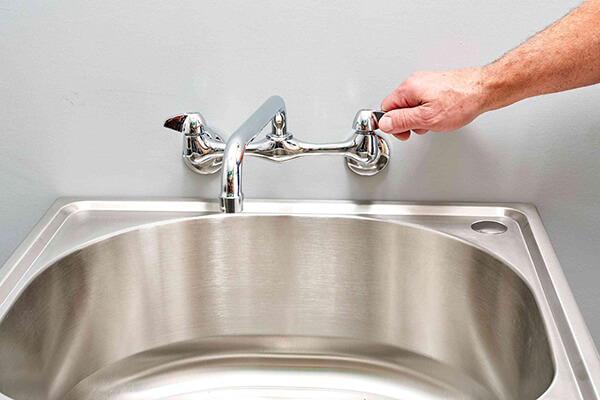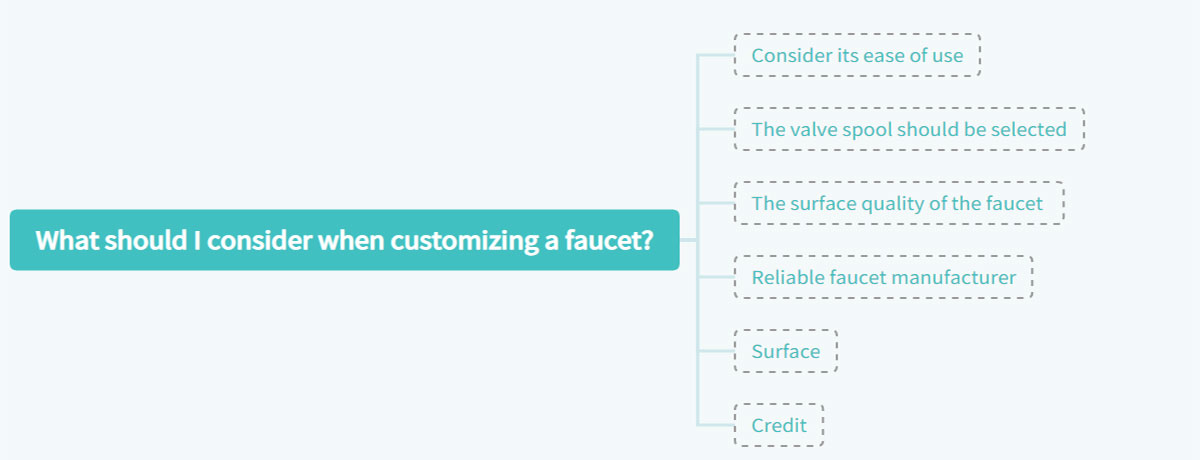A faucet is a fixture used to pull or regulate the flow of liquids, especially from pipes. It is widely used in homes, offices, laboratories, and other places. Its function is to maintain water flow control and stop wasting water when people don’t need it. It is mainly made of waterproof materials such as stainless steel, brass, and zinc alloy, plastic, etc.
1. What is the structure of the faucet?
Inside the faucet, there are three main parts at work. The first component is a pipe from the water source to the faucet. The second part is the device involving channels and stoppers. The stopper is equipped with a rubber gasket that can turn the water flow off or on. Third, extend a short section of pipe between the channel and the faucet outlet.
1) What is a faucet cartridge?
A faucet cartridge is the part of the faucet that controls the water flow. It is usually made of brass or plastic and is located inside the handle of the faucet. The cartridge has a hole in it that allows water to flow through when the handle is turned on.
There are two main types of cartridges: compression and ceramic discs. Compression cartridges have washers that seal the water in, while ceramic disc cartridges have a rubber seal that stops the water from flowing. Both cartridges can wear out over time and must be replaced. If your faucet is leaking, chances are you need to replace the cartridge. To do this, you will need to purchase a new cartridge and follow the instructions in your faucet’s owner’s manual.
2) Benefits of a faucet cartridge
While faucet cartridges may seem like a small and insignificant part of your home’s plumbing, they actually play a vital role in the function of your faucet. Faucet cartridges are responsible for controlling the flow of water from your faucet and can also help regulate the water’s temperature. Cartridges can be made from ceramic or plastic, and they are available in various sizes to fit most standard faucets.
One of the most significant benefits of using a faucet cartridge is that it can help prolong your faucet’s life. Controlling the flow of water helps to prevent wear and tear on other parts of the faucet, such as the valves and seals.
(Another related post: Touch vs. Touchless Faucet: What is the Difference?)
2. How does a faucet cartridge work?
When you turn on a faucet, water flows out. But how does it know to stop flowing when you turn it off again? The answer lies in the faucet’s cartridge.
The cartridge is a small, cylindrical piece located inside the faucet body. It contains a rubber O-ring that seals against the inside of the faucet body and a disc or ball that controls the flow of water through the faucet.
When you turn on the faucet, the handle moves the disc or ball forward, opening up a gap for water to flow through. When you turn off the faucet, the handle moves the disc or ball back into place, sealing off the gap and stopping the water flow.
1) Types of faucet cartridges
There are many different types of faucet cartridges on the market today. The most common type is the washerless cartridge, which uses a rubber or neoprene seal to prevent water leaks. These cartridges are typically brass or plastic and can be found in single-handle and double-handle faucets.
Another cartridge type is the disk type, which uses a metal disk to control the flow of water. These cartridges are often made of stainless steel or ceramic and can be found in both single-handle and double-handle faucets. Disk cartridges are less likely to leak than washerless cartridges, but they can become clogged with sediment over time and may need to be replaced more frequently.
The third cartridge type is the ball type, which uses a metal ball to control the water flow.
2) Faucet cartridge maintenance
A faucet’s cartridge is a central component that controls the flow of water through the fixture. Over time, mineral deposits can build up inside the cartridge, causing it to become clogged and less effective. To keep your faucet working properly, it is important to clean and maintain the cartridge regularly.
To clean the cartridge, start by removing it from the faucet body. Use a small brush or toothpick to remove any debris inside the cartridge. Rinse thoroughly with water and reassemble the faucet. If your faucet has a separate aerator, be sure to clean that as well.
It is also a good idea to lubricate the O-rings on the cartridge with the plumber’s grease before reinstalling it.
(Another related post: Top 10 Best Tap Manufacturers In India)
3. What is a normal type of faucet?
There are many kinds of taps. In fact, the options are almost endless. Depending on the function and style of the sink, there may be a perfect tap deck.
In general, most homes and businesses will have at least one of four different faucet types. These include:
1) Disc faucet
These types of faucets usually have a handle that can be rotated. One side produces hot water, while the other provides cold water. Lifting the handle can create low or high water pressure, depending on whether it is pushed down or up.
2) Filter element faucet
One of the more modern types. These faucets can have two handles but usually, come with one. The internal cartridge is attached to the handle. Special holes allow cold and hot water to flow.
While the cartridges of earlier models were made of metal, most current cartridges were made of rubber. These faucets are similar to disc faucets in that one faucet releases hot and cold water.
3) Spherical faucet
The main difference between spherical faucets is that they do not require a gasket for construction or installation. As with disc and cartridge faucets, spherical faucets usually have a handle to monitor water pressure and temperature.
4) Compression faucets
These faucets are old-fashioned and are often found in homes that have been around for a while because they are one of the earliest faucet types ever made. Compression faucets are faucets that may have separate hot and cold water handles.
Since deck plates usually have a single hole, you can install one on almost any type of sink, with the exception of a compression faucet as it has two handles.
Many faucet deck plates are made of metal because it is a sturdy material that can withstand frequent sink use. They are usually polished chrome and brushed.
(Another related post: A Complete Guide for Buying Faucets)
4. How much does a faucet usually cost?
The typical range price for a faucet is between $158 and $339. The labor cost of kitchen faucets is between $260 and $480. These costs do not include the price of all faucets, as there are so many types of taps on the market today.
5. What are the factors that determine the price of a custom faucet?
The following are factors of determine the price of a faucet.
1) Appearance
The outer surface of the faucet is usually chrome-plated. The plating of the product has specified process requirements and has undergone a certain period of salt spray testing.
No corrosion for the allotted time. In the case of sufficient light, the product can be placed in the hand for direct distance observation. The Surface of the faucet should be as bright as a mirror, with no oxidation spots or burn marks. Careful observation, no pores, no foaming, no leakage plating, uniform color. There are no burrs and no grit to the touch of the hand. Press the Surface of the faucet with your fingerprint, the fingerprint spreads quickly, and it is not easy to stick to the scale.
2) Materials
The main parts of the faucet shell are generally made of brass, which has undergone sand washing, turning, acid dipping, pressure resistance, polishing, electroplating, and other processes. Three-bath faucet handle, decorative nut, and switch valve are basically made of brass, zinc alloy, and ABS engineering plastic. Wall covers are made of copper, stainless steel, and plastic. Connection nut and eccentric joint, outlet shell made of brass. Brass material is recommended.
The plating quality of brass products can be guaranteed, and the corrosion resistance time is longer. The higher the purity of the brass, the better the plating quality and the less it is likely to be damaged. The plating quality and corrosion resistance of galvanized alloys are poor, while ABS process plastics are the cheapest and the plating quality poor. It can be identified by weight estimates, minor surface scratches, and surface plating quality. Brass is heavier and harder, zinc is lighter and softer, and plastic is the lightest and softest. However, according to national standards, zinc alloy materials are not allowed for components that are in direct contact with drinking water.
3) Function introduction
Faucets come in a variety of styles and functions. According to the use, it is generally used for wash basins, kitchen sinks, bathtubs, showers, bidets, etc. Depending on the function, there are normal types, sensor types, constant temperature types, etc.
4) Valve spool
The spool is the heart of the faucet, and the ceramic spool is considered the best spool. The high-quality products are made of ceramic valve spools with strong wear resistance and good sealing properties. Generally, it can be used more than 300,000 to 500,000 times. Low-grade products are mostly made of copper and rubber seals for short service life. But the price is lower.
5) Surface
The faucet surface should be shiny, with no burrs, no pores, and no oxidation spots when touched. The body of a high-quality faucet is usually made of copper. After molding and polishing, the Surface is first plated with acidic copper, then nickel plating and chrome plating (three-layer electroplating). Ordinary products are generally only nickel-plated and chrome-plated (two layers of electroplating). Ordinary products are coated with specific process requirements and pass the neutral salt spray test, without rust within the specified time. Therefore, high-quality faucet products are tightly structured, evenly coated, and smooth, and delicate in color. After long-term use, they can remain bright as new.
6) Credit
Gently turn the handle to see if it is light and flexible, without clogging. Check that all parts of the faucet, especially the main components, are assembled tightly and solidly, and should not be loose.
(Another related post: What are the Best Materials for Bathroom Faucets?)
6. What should I consider when customizing a faucet?
What should you consider when you buy a faucet? Here are some tips:
1) Consider its ease of use first
After all, we have to touch the faucet every day, and the inconvenience of using the faucet directly affects our experience, especially when you are in a bad mood or are in a hurry to wash in the morning when the faucet is inconvenient and cumbersome to use. It would be a more exciting and painful thing!
Therefore, in terms of functional use and outlet control, the simpler and more efficient the design of the faucet structure, the better the experience for you, the more convenient maintenance will be when there is a problem, and you will not worry about which one to repair because various parts are broken. You may even lose your entire set of faucets due to complexity and cumbersomeness, which is both a loss and a waste, so opt for a simple and efficient faucet. It will bring a lot of convenience to life and the unity of the problem in the later maintenance, making maintenance easier, easier to judge, and minimizing losses.
2) The valve spool should be selected
When buying a faucet, take care to experience the feeling of the handle turning up and down from side to side. If it feels light and smooth, and the opening and closing are fast, it means that the valve spool used by the faucet is of good quality and has good sealing performance; The quality of the spool is good, indicating heat resistance, low-temperature resistance, wear resistance, durability in use, so the valve spool is very important for a faucet, equivalent to the heart of the faucet.
3) The surface quality of the faucet
On the surface of the faucet, we see a bright mirror-like surface. Usually, the Surface of the faucet is polished and then plated with nickel and chrome. The advantage of this is to avoid oxidation problems on the brass surface and improve the aesthetics of the product; When purchasing, we should pay attention to the plating quality of the faucet, mainly to see whether there is any electroplating exposed, electroplating blister, electroplating coking, electroplating peeling, whether there are pores, whether the color is uniform, etc., is a faucet that is both beautiful and practical.
4) Reliable faucet manufacturer
A reliable faucet manufacturer can make your journey to buy a faucet much easier. For example, at Nicemoco, before making an offer, we will give you some solid advice based on your actual situation. In order to quickly find the right faucet.
(Another related post: How to Identify Your Kitchen Faucet Brand?)
7. How do I install a faucet on my own?
Installing the faucet is not difficult. Considering the price of hiring a person to install it for you, why not try to install it yourself? Here we provide a detailed explanation that you can follow when trying to install the faucet yourself.
Step 1 – If your old faucet is still in place, use a pipe wrench to remove it. However, before you perform this step, make sure that everything is turned off! Also, check the pipes under the sink to avoid any leaks!
Step 2 – Once you’ve turned everything off under the sink, it’s time to start installing the faucet. For this step, use an adjustable wrench to tighten all the nuts around them to make them beautiful and secure! However, make sure not to scratch anything or anyone else while performing this step!
Step 3 – If you have rust on any of your pipes, then you need to get rid of it so that leaks don’t happen on the road. This can be done by using a wire brush!
Step 4 – Now, connect the faucet with Teflon tape and turn everything back on under the sink. You may want to put some towels or rags around just in case anything happens!
Step 5 – Once your faucet has been reopened, use a bucket and throw away all the old parts because you don’t need them anymore! As long as nothing is leaked while performing this step, it is safe for others involved in installing the faucet!
Step 6 – Finally, put all the tools back in place, turn off the tap at the sink, and make sure to wipe everything with a rag. Once this step is complete, all other participants can safely use it again!
The faucet installation process is thus complete!
(Another related post: Top 10 Faucet Manufacturers in China)
8. How much does it cost to hire a person to install a faucet?
Installation fees vary depending on many factors.
On average, you need to pay $246 for a new bathroom faucet installation. The typical range price of a faucet is between $158 and $339. The labor cost of kitchen faucets is between $260 and $480.
These costs do not include the price of the faucet, as there are so many types of taps on the market today. You can find cheaper ones for less than $100 and more expensive ones for a few hundred dollars.
Again, when considering the cost of a faucet, be sure to consider the overall quality and focus on the faucet features you want, not just the price.
(Another related post: Kitchen Faucet: An Ultimate FAQ Guide)
9. Benefits of hiring a professional to install a faucet
While you may think that installing it yourself can help you save money, it’s best to hire a professional to install the faucet for you. There are several reasons for this. Now let’s take a look at some of the benefits.
1) Avoid costly problems
If you have the knowledge, experience, and tools to do the job on your own, there shouldn’t be any problem installing the faucet. However, if you don’t know what you’re doing, you can damage something while you’re working.
You may end up spending more money solving problems you create rather than simply hiring a professional first.
For faucet replacement involving pipes or any other plumbing fixture, you would definitely want to have a licensed, bonded, and insured plumber do the job. They will know where they need to go and how to move the pipe without damaging the pipe or causing a leak.
2) Ensure proper installation
Don’t want hot water coming out when turning the cold Surface or dealing with leaky faucets? Hiring a professional is the best way to avoid these and other problems.
Plumbers know where everything is and may have installed hundreds of other faucets, so they can make sure your faucets are done correctly. Improper installation can also create bigger problems, such as leaking or cracked pipes.
One of the reasons professional plumbers are able to install the faucet quickly and correctly is that they have the right tools to do the job. Plumbing tools are expensive, which makes it difficult for the average homeowner to do plumbing work.
3) Save time
Learning how to install a faucet takes time, and the actual installation takes time. If you’re like most people, you have better things to do and not try to figure out how to replace the faucet just to save a few dollars.
When you hire a professional, you need to spend a fraction of your time, so you can enjoy the new faucet directly when you finish it instead of getting frustrated in the whole process.
(Another related post: Kitchen Faucet Flow: Everything You Need to Know)
10. How do I keep my custom faucet clean?
Regular cleaning, maintenance, and prevention are needed to help keep a faucet clean.
When cleaning and maintaining faucets, regardless of the Surface, there are some rules of thumb that can work across the board.
In general, soft wet cloth like microfiber, and a small amount of mild soap are what you need to clean the faucet regularly, just remember to dry it with a dry soft cloth so that no water spots will appear. This alone should maintain the natural luster of the faucet.
Whenever the faucet gets wet, try to dry the faucet with a soft (microfiber) cloth to prevent water spots or damage to the sedimentation. If you do have water spots on your faucet, the warm water on a soft, damp cloth should easily remove them.
Avoid using abrasive scrubbers or mats, as they can ruin the luster of the faucet by scratching and abrasive surfaces. The use of a soft-bristled toothbrush is sufficient to make hard-to-reach areas or places where water deposits are most likely to settle.
Again, avoid using any industrial-grade, bleach, or abrasive cleaners. Especially those that contain hydrofluoric, hydrochloric acid, phosphoric acid, and corrosive agents. Read the product label carefully for cleaners that may discolor, rust, or damage specific faucets.
In most cases, scrubbing the toothbrush onto the stain with baking soda and a little water should solve the problem. Use a polish or wax (aerosol or liquid) on a matte faucet to provide a consistently uniform look and prevent fingerprints and other everyday traces.
Overall, non-abrasive cleaners and scrubbers are ideal for preventing scratches and faucet damage. When choosing and using cleaners, always keep in mind the Surface of the faucet.
(Another related post: How to Install a Shower Drain Cover?)
11. Why is my custom faucet leaking?
Your first job is to see if the faucet leaks when it’s on, or if a leak occurs when the water is turned off. Sometimes, stains around the fixture or faucet rod may indicate a leak. In either case, look for the following criteria:
1) The faucet leaks and drips
In washing machine-type faucets, a leak or drip from a closed faucet usually indicates wear out of the washing machine. Thankfully, the washing machine is inexpensive and easy to replace. However, it could also be more complex damage to the seat.
For other faucet types, the problem may be caused by a damaged o-neck.
Depending on your skill and knowledge level, you can solve these problems yourself or hire a plumber.
2) Faucet handle or stem leak
In faucets, a leak in the faucet handle or stem can be caused by worn or bent stem packing, a deteriorating stem packing, or a loose stem packing nut.
When this problem occurs in no-wash faucets, the culprit is usually a faulty valve or filter element. You need to replace the faucet.
Again, while you may be able to solve these problems on your own, you are more likely to want to hire a plumber for these more complex issues.
3) Leaking water behind or under the faucet
If the faucet is not tightly fixed to the fixture, countertop, or wall, splashed water may flow beneath it. This can lead to staining and damage to walls and floors.
Try tightening the faucet under the sink. You need to use a special tool called a basin wrench. This tool enables you to enter narrow positions at strange angles. Thankfully, they can be purchased at your local hardware store for $10-25.
4) Noisy faucets
All kinds of faucets should run smoothly and quietly. So, when you hear a noise while using the faucet, it indicates that there is a problem that could lead to a leak.
The whistle of the water is emitted, indicating that the interior design of the faucet is defective. This can be difficult to solve. Call a plumber for more expertise.
The fluttering and thumping sound of the water flow may be caused by loose washers. You should need to replace it.
When you turn off the faucet suddenly, you may hear the sound of a hammer tapping on the pipe. It’s called a “water hammer” and it’s not a faucet problem. The loud hammering sound came from the pipe behind the wall. This is caused by the sudden stop of the water and its change of direction. This creates a shock wave, which is the sound you hear.
5) The faucet is damaged or corroded
A damaged or corroded faucet can immediately or eventually cause the faucet to leak.
For example, a ceramic faucet handle may crack. Corrosion can erode metals, creating pinholes in leaking places. In this case, the best practice is to simply replace the damaged or corroded faucet.
(Another related post: How to Design a Kids’ Bathroom?)
12. How to fix a leaky faucet?
Once you’ve identified the cause of a leaking faucet, you can fix it – unless it’s an issue that requires professional help. Follow these steps to fix the leaking faucet yourself:
Step 1: Determine which type of tap you have. The most common types are spherical faucets, cassette faucets, and ceramic disc faucets.
Step 2: Turn off the water supply from the leaking faucet. Look at the pipes under the sink for water shut-off valves. There should be two – one for heat and one for cold. Rotate clockwise with your hands until they close.
Step 3: Block the drain pipe with a sink plug or rag so you don’t lose any of the little parts in it.
Step 4: Remove all trim parts from the handle knob. Underneath them, there should be a screw to attach the handle to the stem. Unscrew and remove the handle.
Step 5: Release the packing nut with a wrench and then release the valve stem. Inspect these parts for any damage. If they are damaged, replace them.
Step 6: Next, check the O-rings and gaskets inside the valve seat. Replace the gasket and o-ring and see if this solves the problem.
Step 7: Reassemble the sink and test for leaks.
Step 8: If steps 1-7 don’t work, it may be in your best interest to call a plumber to check the problem.
(Another related post: Smart Faucet: All You Need to Know)
13. Conclusion
This is the relevant knowledge about customized faucets. It includes the structure, working principle, type of faucet, and what factors to consider when customizing a faucet. I hope that after reading this article you will have a further understanding of customized faucets.
How useful was this post?
Click on a star to rate it!
Average rating 5 / 5. Vote count: 2
No votes so far! Be the first to rate this post.
















